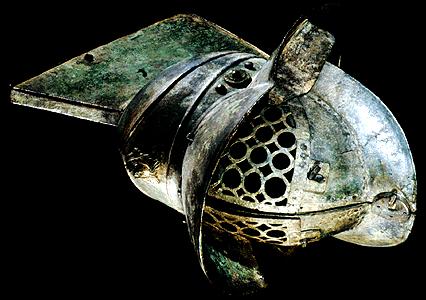
beautyme collections culture cuisine motor music search

GLADIATORS AND CAESARS
The Power of Spectacle in Ancient Rome
21 October 2000 - January 2001
www.british-museum.ac.uk
Bread and circuses - panem et circenses - were what Romans demanded of their emperors, if we are to believe the satirist Lucian. For more than five hundred years spectacular events in amphitheatres, circuses and theatres, in an age when the multi-media we now all take for granted did not exist, were the most important leisure activities of the masses throughout the Roman empire.
This exciting exhibition will look at all aspects of the entertainment industry in ancient Rome and point up many surprising modern parallels, using objects lent by European museums in addition to major pieces from the British Museum's own collections. Individual sections will be devoted to gladiators and their fighting styles and techniques, heavy physical sports, chariot racing and the theatre, all seen from a variety of perspectives. The exhibits range in size from a huge stone relief showing gladiatorial combat to the tiny bone discharge ticket which gave a gladiator his freedom. In between are bronze models of chariots, gladiators' tombstones, bronze and pottery figurines of gladiators and wrestlers, stone busts and statues of boxers, theatre masks of pottery and stone, a floor mosaic with a pair of gladiators, frescoes and stone reliefs showing scenes from plays and a plate with a portrait of an actor.
Lavishly ornamented gladiatorial weapons bring vividly to life the splendour and brutality of the arena, while graffiti cut into wall-plaster celebrate long-dead gladiators. Everyday objects such as oil-lamps and knife handles decorated with images of gladiators, actors and charioteers remind us that spectators then as today bought fan merchandise. The imagery of chariot racing above all had an enduring popularity, partly because the rewards and hazards of the race-course were seen as a metaphor for life. Circus scenes are depicted on frescoes and other wall decorations as well as on the sides of richly carved sarcophagi, while a terracotta plaque records with terrifying reality the consequences of a chariot crash.
2000 years on the Roman games may seem remote in time, but their fascination continues. This exhibition will show that they mirror many features of sport today, not least in their intensity of public interest. The theme is strongly represented in films. Many people have lasting memories of 'The Robe', 'Spartacus' ( telling the story of the most famous of all gladiators, who led an uprising against Rome which symbolised the fight against slavery) and 'Ben Hur'. To explore this connection a major film programme will accompany the exhibition. There will also be an audiovisual presentation, including computer reconstructions of arenas and an extensive educational programme.
Fig.: Bronze helmet of a heavy-armed gladiator. Roman, 1st century AD.